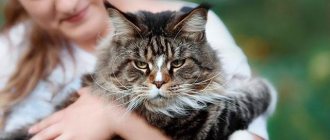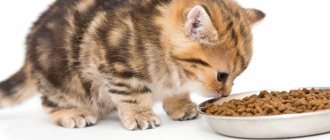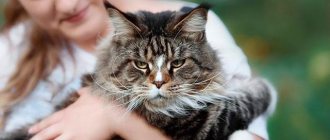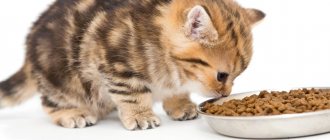The weight of a cat depends primarily on the breed, lifestyle and nutrition. For example, the large Maine Coon breed: the weight of a kitten at birth is already greater than the average weight of a cat and is about 130-150g; for comparison, the weight of a Scottish kitten is 80-120g. In the Scottish breed, the weight of fold-eared cats and straight-eared cats does not differ. British kittens also weigh approximately 80-130 grams at birth.
The weight also differs by gender, for example, the weight of a British cat is 5-7 kg, and the weight of a British cat is 3-5 kg (weight of British cats by month). Read all about the British breed here. The table shows the dynamics of the cat's weight by month: the weight of a Maine Coon kitten, the weight of a British kitten by month, the weight of a Scottish kitten by month.
The cat's weight by month shows a general trend of intensive growth in the first month, then the weight is gained a little more slowly, the cat's weight per year practically reaches its maximum, a stable normal weight of the cat is achieved at about 2.5 years. The cat's weight is shown in the table, first by week, then by month.
How does a kitten's weight change as it gets older?
If babies are healthy, they will gain weight daily. A day after birth (second weighing), the weight of newborns, if they are not sick, will increase by at least 8-10 g. The strongest kittens gain 14 g in weight by the second day of life. If a baby whose weight at birth corresponded to the norm, during the second day of life he did not gain at least 7 g, this should alert the breeder.
A newborn baby should weigh up to 170 g
During the first week of life, a newborn's weight may double.
Important! The kitten, who lived for 10 days and gained 168-174 g, has passed the first critical milestone. The majority of newborns die during this period. Almost always the cause of death is a lack of mother's milk.
Kittens are fed around the clock at intervals of two hours. When eating, the kitten should lie on its stomach. It is unacceptable to feed your baby adult food, such as cow's or goat's milk. This can cause diarrhea and, as a result, weight loss and death. The breeder must also weigh the kittens daily and record the results.
What are the norms for weight gain for kittens?
The first six months of a kitten's life are the most active in terms of growth. Accordingly, if the baby is healthy and develops normally, he will regularly gain weight:
- Before the baby turns 1 month old, he rapidly gains weight - about 15 g per day. At the same time, by the end of the 1st week, the kitten should double its birth weight. Weigh him daily during this period.
- From 1 to 2 months, weight gain occurs systematically, on average 100–150 g per week. Weigh the baby once every 3 days.
- After 2 months, weight gain varies from person to person. It depends on the breed and nutrition of the animal. He is weighed weekly for up to 6 months, then once a month for up to a year. It is important that there is weight gain. If it is absent, you should contact your veterinarian to find out the reasons.
Since there are no exact indicators of body weight gain (much depends on the individual characteristics of the animal, its living conditions and diet), the owner should focus on the average weight standards for kittens.
Table: average body weight of kittens in the first 6 months of life
| Age | Weight |
| 1–6 days | 70–130 g |
| 7 days | 85–200 g |
| 7–14 days | 225–400 g |
| 14–21 days | 285–500 g |
| 1 month | 500–750 g |
| 2 months | 1000–1500 g |
| 3 months | 1700–2300 g |
| 4 months | 2500–3600 g |
| 5 months | 3100–4200 g |
| 6 months | 3500–4800 g |
Short-term stabilization of weight in a kitten
The phenomenon of short-term weight stabilization often occurs. There is no need to panic if the kitten’s weight gain “frozen” for several days, and then continues in the same progression.
Such an anomaly can manifest itself at any time stage of the baby’s life. It often occurs when there is a transition from breastfeeding to regular food (dry food or natural food). This is due to the fact that the baby’s body goes through a period of adaptation to receiving new nutrients.
However, you should worry if there are no changes for more than a few days (for example, a week). This may mean that the kitten is malnourished or sick or infected with parasites. You should visit a veterinarian as soon as possible if, after weight stagnation, body weight begins to decrease rather than increase.
Table: kitten weights by month (values for popular breeds)
| Kitten age | Maine Coon cat weight (g) | Maine Coon cat weight (g) | British cat weight (g) | British cat weight (g) | Scottish cat weight (g) | Scottish cat weight (g) |
| Newborn kitten | 120–140 | 120–160 | 60–140 | 70–140 | 60–140 | 70–140 |
| 1 Week | 180–230 | 200–260 | 110–250 | 240–260 | 110–250 | 240–280 |
| 2 week | 280–340 | 400–360 | 150–360 | 340–400 | 140–360 | 340–400 |
| 3 week | 420–550 | 440–600 | 210–420 | 400–630 | 200–420 | 390–630 |
| 4 week | 560–680 | 630–750 | 250–600 | 550–740 | 240–600 | 540–740 |
| 2 months | 1100–1400 | 1200–1500 | 450–900 | 1000–1700 | 400–900 | 1000–1700 |
| 3 months | 1700–2300 | 1800–2300 | 1000–1500 | 1500–2500 | 1000–1500 | 1500–2500 |
| 4 months | 2700–3600 | 3000–3800 | 1700–2400 | 2100–3900 | 1700–2400 | 2100–3900 |
| 5 months | 2900–3900 | 3000–5500 | 2200–2900 | 2600–4300 | 2200–2900 | 2600–4300 |
| 6 months | 3200–4000 | 3900–6000 | 2300–3600 | 3000–5400 | 2300–3600 | 3000–5400 |
| 7 months | 3500–4100 | 4200–6500 | 2400–3900 | 3300–5600 | 2400–3900 | 3300–5600 |
| 8 months | 3800–4300 | 4500–6900 | 2500–4100 | 3500–6000 | 2500–4100 | 3500–6000 |
| 9 months | 4100–5000 | 5000–7000 | 2500–4300 | 3800–6400 | 2500–4300 | 3800–6400 |
| 10 months | 4200–5500 | 5200–7700 | 2500–4400 | 4100–6700 | 2500–4400 | 4100–6700 |
| 11 months | 4300–6000 | 5700–8000 | 2500–4500 | 4300–6800 | 2500–4500 | 4300–6800 |
| 12 months | 4500–6300 | 5700–9000 | 2500–4600 | 4500–7000 | 3500–4600 | 4500–7000 |
How to determine weight standards for a mongrel kitten
When it is not possible to determine what breed a kitten is, it is necessary to use average indicators. The size of the baby will change in accordance with its development. There are a number of factors that allow you to predict a kitten’s weight gain. For example, when he switches from breast milk to a normal diet, the weight may decrease slightly.
After the 6th month of life, weight gain is not of decisive importance. If the cat is active, eats well, and has no problems visiting the litter box, then there is no need to worry too much. The veterinarian should be observed on a schedule determined by the doctor (basically it coincides with the vaccination schedule).
Having mongrel cats and a dog adopted from the street, I regularly visit the veterinarian. All my animals have veterinary passports, are vaccinated and sterilized. This way I protect not only them, but also my family. After all, some diseases (and at least the same worms) can be transmitted to humans. Since my children play with animals, I have a strict order in this matter.
How much should a cat weigh at different stages?
Chihuahua weight by month and week: table
During the first 15–20 days of life, kittens spend most of their time sleeping. After about 16 days from the moment of birth, babies begin to be interested in the events happening around them, frolic and play.
The table shows the weight of a growing kitten by month:
| Kitten age | Kitten weight by month | Note |
| 1st day of life | Approximately 99 g | Average weight of a newborn kitten |
| 7th day of life | 149 g | If a 7-day-old kitten weighs less than 99 g, he is either seriously ill or malnourished. |
| 14th day of life (0.5 months) | 170 g | The weight of a kitten is given, which is not sick with serious illnesses, but also does not receive the maximum portion of attention. |
| 21 days of life (0.7 months) | 225 g | With special care, kittens reach the specified weight at the age of 14 days |
| 35th day of life (1.2 months) | 450 g | The weight of an absolutely healthy, naturally strong kitten is indicated. |
| 2 months from the date of birth | 900 g | The cat no longer feeds her kittens; their future fate depends entirely on the owner. The permissible minimum weight at this age is 710 g |
| 3 months | 1400 g | The average weight of a typical kitten is indicated. |
| 4 months | 1800 g | Average weight |
| 5 months | 2300 - 2900 g | Male kittens weigh more than their sisters |
The table shows the average weight. The exact indicators depend on the breed, gender and health status of the kitten.
Outbred kittens develop in approximately the same way as purebred kittens, only their mortality rate is higher due to the lack of additional nutrition.
A weak kitten weighs very little from the first days of life
Note! An animal that at the time of birth weighed less than its littermates will not be able to do without additional nutrition. Pushed away from his mother's nipples by stronger brothers and sisters, he does not receive enough nutrition, does not gain weight and becomes weaker.
Kittens stop needing mother's milk within a month after birth. By this time, their fangs and incisors have erupted, their ears take a vertical position (in representatives of straight-eared breeds), and their weight reaches 440-470 g. A kitten that has reached six months of age is considered an adult and weighs about 3 kg.
What can a kitten weigh at birth?
The weight of a kitten at birth can depend on various characteristics:
- Gender. At the moment of birth, a cat may not differ in weight from a female cat, but this difference becomes noticeable after some time. Males are usually a little larger than female cats, and therefore weigh a little more.
- Number of kittens born. It has long been noted that the more numerous the litter, the greater the underweight of each individual.
- The completeness of the diet of a mother cat during pregnancy.
- Belonging to a certain breed. For example, a Maine Coon kitten at the time of birth will weigh more than a baby, for example, of the Siamese breed.
Newborn kittens of large breeds (for example, Maine Coons) will weigh more than their graceful relatives
A newborn kitten most often weighs no more than one hundred and twenty grams. He is still blind and mostly immobilized. All he can do is eat, grow and get enough sleep. Staying in this mode, the baby can gain up to 15 grams per day.
Rules for weighing kittens
German Shepherd weight by month: table
Kittens must be weighed every day. If they look healthy, once is enough. Sick newborns, as well as those whose weight at birth was less than 80 g, are weighed twice a day. The weakest and most disease-prone babies are usually born in large litters (5 or more kittens).
Important! Experts recommend weighing them at the same time to get the best idea of newborns' rate of weight gain. Without this, the breeder will not be able to determine the amount of additional nutrition. Overfeeding kittens is no less difficult than underfeeding.
During the weighing session, the mother cat must be kept near the kittens so that she can see what is happening with her children. Excessive worry can negatively affect the quality of mother's milk. To create the most accurate picture of kittens growing up, experts advise:
- Mark identical kittens with different colored food dyes. This will make it easier to identify them. The tags will have to be periodically updated, since the cat, licking the babies, will wash them off;
- use electronic kitchen scales as the most accurate;
- record weighing results.
How to weigh a kitten correctly
If the kitten is very small, then in order to weigh it, you can use a regular kitchen scale and a small box. To prevent the kitten from turning weighing into a game, the best time for the process is immediately after sleep. If the baby starts spinning and jumping, the indicators will be inaccurate. Trying to hold a playful baby with your hand can also get a distorted result.
To get the most accurate figure for the baby’s weight, you can follow two methods:
- First, weigh the box, then put the kitten in it and record the result again. Subtract the difference.
- Place the box on the scales, and only then turn them on. They will show zeros. After this, we put the baby in a box and get the figure for his body weight.
It is more convenient to weigh mobile kittens in small containers or boxes to get a more accurate result.
This way the owner will receive an exact figure in grams, which can be entered into the animal’s weight diary.
Video: how to weigh a cat
What does weight depend on?
Yorkie weight by month: table, standard, how many months it takes to grow
Male kittens weigh more than females as they grow up. With each new weighing, the difference increases. The weight of mature males and females is influenced by a number of factors.
Bengal cats
During the first week of life, the weight of a Bengal kitten can reach 250 g, and after another three weeks the baby will weigh from 400 to 500 g. A three-month-old teenager weighs about a kilogram.
A Bengal kitten reaches 1 kg at 3 months
Bengals are a fairly heavy breed, but they are never fat. Kittens are very active and energetic, they run a lot, they are always in excellent physical shape, although they look well-fed and even overfed. They owe their appearance to their natural muscularity.
Note! The weight of a Bengal kitten depends to the greatest extent on the development of its muscular system. We must not forget that Bengals are big-boned animals.
"British"
On the 7-8th day of life, 70-gram babies already weigh 110-150 g. When they are two weeks old, their weight will increase to 210-420 g. The specific weight depends on gender, health status and the number of kittens in the litter.
Scottish Fold
If at birth cats of this breed weigh 70-120 g, then after two weeks these figures increase to 440 g. A two-month-old “Scottish” kitten weighs about 800 g. After another month and a half, its weight will increase to 1.5 kg.
Representatives of this breed, even when they grow up, do not cease to look like teddy bears with a rounded head on a short neck and large, widely spaced round eyes. Males that have reached puberty weigh from 4 to 6 kg, and females - from 2.7 to 4 kg.
“Scots” are usually good-natured and calm. They love to be outdoors and never miss an opportunity to participate in outdoor games. Loneliness and a sedentary lifestyle make them depressed and, as a result, lead to obesity.
Siberian cats
Siberian cat kittens are born weighing 60-130 g. Girls and the weakest newborns weigh less, boys, as well as kittens born at the beginning of the litter, have the greatest weight. During the first month of life, their weight increases by 12-15 g daily.
Sphinxes
Representatives of this species require high-calorie food to avoid hypothermia. The weight of females that have reached the age of 8-9 months can reach 3-4 kg. Males weigh from 4 to 5 kg.
The Sphynx needs to be fed a special diet
Sphynx kittens are not separated from their mother until they are one month old. During this period they feed on her milk.
Thai cats
The weight of a 3-month-old male can reach 1.8 kg. A female at this age weighs about one and a half kilograms. When the kittens are six months old, the male will weigh approximately 2.9 kg and the female 2.3 kg.
Factors affecting baby's weight
Fluctuations in a cat's weight may indicate changes in the animal's body. This may not only be malnutrition, but also more serious problems. Hormonal disorders, diseases of the cardiovascular system and gastrointestinal tract are reflected in the weight of the animal. Factors that affect the baby's weight:
- Breed. The weight of Maine Coon and Ragdoll kittens is significantly different from the weight of Scottish cat kittens. Therefore, different weight tables are provided for different breeds. If the kitten is outbred, then pay attention to the weight of its mother and, based on this indicator, select a table for the weight of newborn kittens.
Maine Coon kittens weigh much more than kittens of other breeds
- Floor. Boys are born larger than girls and gain weight faster.
- Number of kittens in the litter. In large litters, kittens are often born weak and weigh little. Increased competition for space at the mother's nipple also plays a role.
- Mother cat nutrition. The quality of milk, its calorie content and quantity directly depend on the cat’s nutrition. An underfed cat will not be able to feed her kittens.
- Cat health. Many postpartum complications in cats interfere with normal feeding. For example, with mastitis, a cat’s nipples hurt, and she does not allow the kittens to feed from it. Or there may be an infection in the milk, causing the kittens to get sick and not gain weight.
How to prevent obesity in kittens
The change in nutrition plan is carried out gradually. Experts advise extending the transition to a diet for 7-14 days. If the kitten does not receive its usual food for 3 days, and the new food is not to its taste, the period of forced fasting may affect the functioning of the liver. The best way to transfer an animal to a new food system is to gradually, in small portions, replace the usual food with dietary food.
Important! To prevent the kitten from overeating, portions must be dosed, and feeding should be done strictly according to the clock. If food is constantly at the animal’s disposal, it will be difficult for the owner to keep track of exactly how much the baby eats and at what time.
After filling the bowl with food, leave it for about 20 minutes and then remove it until the next meal. If the cat has already reached adulthood, it is recommended to give food 3-4 times a day during the first week, and 2-3 times a day during the second week. Ultimately, the daily dose is divided into 2 doses.
Portion sizes depend on the type of food and calorie content. The animal should receive the recommended daily dose corresponding to its weight (indicated on the package).
Your kitten: 6 weeks
- Physical Development : At 6 weeks of age, a kitten's teeth begin to reach the final stage of early development. The molars will begin to appear. The eyes will still be blue, and vision and hearing will be fully developed.
- Behavioral Development : Six-week-old kittens will confidently interact with peers, fight, attack and defend themselves. They will be curious about their surroundings and will be eager to explore. They will improve their self-care skills. At six weeks old, kittens become coordinated enough to jump off furniture and land on their feet.
- Average temperature : 37-38 ℃. At this age, a heat source is no longer required if the environment is at a comfortable temperature of 21-23 degrees.
- Average weight : 650-750 grams.
- Care Information : Kittens should receive adequate amounts of wet food after weaning. Always provide access to water, food and a shallow litter box. At six weeks, kittens should receive their first FVRCP vaccine to protect against viruses (rhinotracheitis, calicivirus and panleukopenia).
© shutterstock
How much should a grown-up cat and cat weigh?
Bengal kittens stop growing when they reach 2 years of age. By this time, the weight of the female can reach from 3600 to 4500 g. The male will weigh 4500-6800 g. In some cases, the weight of an adult male Bengal can reach 10 kg or, conversely, not reach the norm (the minimum weight of a male is 3600 g), but This is rather an exception to the rule, rather than the norm. The same can be said about females. Female cats sometimes weigh much more than males.
Many breeders of Bengal cats believe that the weight of their pets exceeds the norm or, conversely, is below the acceptable minimum. The fact is that cats of this breed remain children longer than their relatives. They usually reach full physical development at the age of 3 years or so.
“The British” do not control their food intake, which is why they later suffer from obesity
Important! A peculiarity of British cats is their tendency to obesity. If the breeder does not regulate the pets' diet, they quickly gain excess weight.
Table for calculating the weight of a mature British cat by age.
| Gender | Permissible minimum weight | Permissible maximum weight | Expert opinion |
| 2 year old male | 4.1 kg with a height of 40 cm | 7.7 kg with a height of 50 cm | 6 kg regardless of height |
| 2 year old female | 3.2 kg with a height of 35 cm | 5.4 kg with a height of 45 cm | 5 kg regardless of height |
If the British dog's weight falls far short of the acceptable minimum, the breeder should think about additional nutrition. A veterinarian will help you decide on the amount and composition of feeding. The procedure for treating obesity in cats is not much different from the treatment for people suffering from excess weight. The best cure in both cases is diet and physical activity. If an obese kitten whose body is constantly growing, he most likely leads a sedentary lifestyle and receives an excessive amount of food. It is enough for the breeder to change the lifestyle of the ward.
For mature Siberians, a weight of 4 to 10 kg is considered normal. Both males and females are distinguished by their large dimensions and powerful muscular bodies. Female Siberian cats weigh between 4 and 6 kg. Males, if not sick, reach 6-10 kg.
For your information! To find out how much a Siberian cat weighs, you will need a bathroom scale. Experts suggest the following method: the breeder first weighs himself, and then, picking up the cat, weighs himself again. All that remains is to calculate the difference.
Thai male cats, upon reaching maturity, weigh from 5 to 6.8 kg. The weight of mature females ranges from 3.6 to 5.4 kg. Cats of this breed are natural gourmets; they never miss an opportunity to eat deliciously, so breeders have to constantly monitor their weight.
Weight value
Determining the weight of a pet kitten is an excellent way to assess its growth and development. If weight is gained slowly, this indicates health problems. Also, a nursing cat may have problems with well-being. The second reason for poor recruitment is a lack of nutrients (for example, many cubs were born in the litter).
Kittens are characterized by rapid growth, as in natural conditions they leave their mother at the age of 12–16 weeks. Therefore, at the beginning of their lives, they should eat a balanced and high-calorie diet. Every week the cub should gain 50–100 g. If the animal gains less, it must be shown to a veterinarian. But there are cases when a pet experiences a temporary stabilization of this indicator. Then the set resumes and proceeds at an accelerated pace.
For each breed of cat there is a special table that indicates the normal weight of the animal depending on its age. This is important to know, since the norm is directly dependent on two indicators - age and breed.
Therefore, you can find out how much a kitten of a particular breed should weigh without any problems. Do not forget that this indicator is seriously influenced by a nutritious, balanced and rational diet.
Number of kittens in the litter and their weight
The very first pregnancy ends for a cat with the birth of 2-3 kittens. Their weight in most cases is maximum - about 170 g. However, it is possible that weak and extremely light kittens will be born in the first litter. The minimum weight of a viable baby is:
- 60 g for a Siberian cat cub;
- 70 g for a Scottish Fold kitten and for representatives of most breeds.
For your information! After the second and subsequent pregnancy, the cat will become the mother of at least 8 kittens. Some females are capable of acquiring 8 or even 10 kittens when giving birth for the first time, but such cases are quite rare.
A purebred cat can give birth to up to 15 kittens.
A pregnant cat can give birth to 1 to 6 kittens
This number is due to the need to continue the race, despite the hostility of the environment, where mortality is much higher than among purebred cats living in comfortable conditions.
Your kitten: 2 weeks
- Physical Development : At 2 weeks of age, kittens' eyes will be fully open and blue. They will have poor eyesight and will not be able to see over long distances. The ear canals will be open, and the ears will be small and round, like a bear cub. If you open the kitten's mouth, you will find that there are still no teeth. The claws will still not extend.
- Behavioral development : Two-week-old kittens will become more coordinated and begin to take their first steps. They will be unsteady on their feet and uncoordinated. Kittens at this age may be curious about the world around them, will not yet play and will spend most of their time sleeping.
- Average temperature : 36-37 ℃. It is important to provide a gentle heat source to keep the kitten warm and stable. At this time, the kitten's ambient temperature should be about 26 degrees.
- Average weight : 250-350 grams
- Care information : Two-week-old kittens live permanently with their mother. If the mother is not present, they should be bottle-fed and kitten formula every three to four hours by a knowledgeable caregiver, encouraged to go to the bathroom, and maintained at an appropriate temperature. Kittens as young as two weeks old may begin to develop degwords.
Diseases in cats that lead to obesity
The cause of extra pounds may not only be overeating.
Obesity is the scourge of many cats
The following diseases are often triggers of obesity:
- hypothyroidism (hormonal disease of the thyroid gland);
- insulinoma (pancreatic tumor);
- hypothalamic disorders;
- problems with the pituitary gland, the organ responsible for the production of hormones that affect metabolism.
Thus, everyone who wants to raise a healthy pet is obliged to control the weight of the animal. It is also important to dose the cat’s food so that he does not suffer from obesity later.
Your kitten: 7 weeks
- Physical Development : All baby teeth will appear by 7 weeks of age. At this age, the kitten's eye color will change and the adult eye color will begin to appear. Kittens' testicles will begin to descend at about 7 weeks.
- Behavioral Development : Seven week old kittens will experience a burst of energy. Sleep will decrease and time spent playing will increase. At this age, kittens can run, climb cat trees, and confidently jump off furniture.
- Average temperature : 37-38 ℃. At this age, a heat source is no longer required if the environment is at a comfortable temperature of 21-23 degrees.
- Average weight : 750-850 grams.
- Care Information : Kittens should receive an adequate amount of wet kitten food and may have dry kitten food as a supplement. Always provide access to water, food and a shallow litter box.











